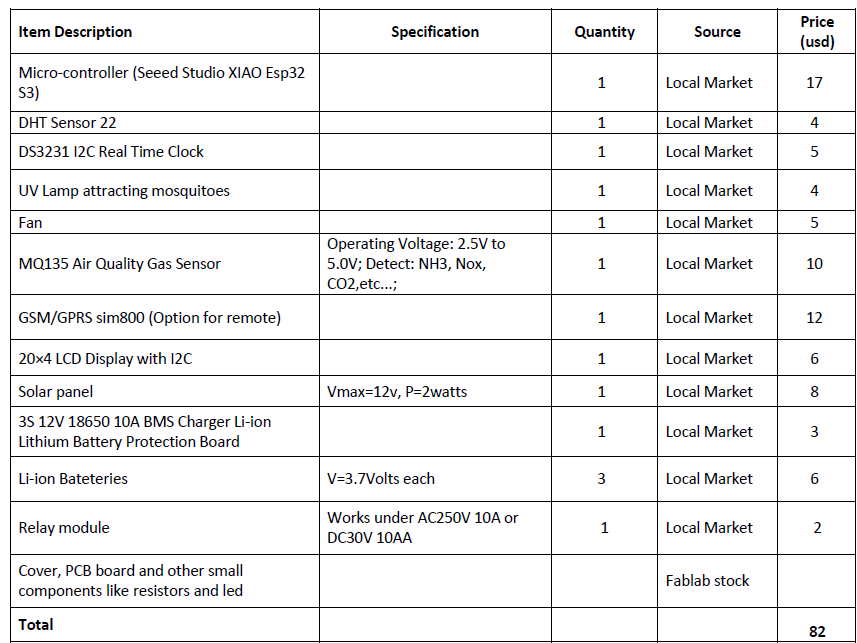WEEK 17: PROJECT DEVELOPMENT
Project Name: Prevention and Control of Malaria with Smart Solar-Powered Mosquito Killer with air quality monitoring facility.
Project Outline
| Activity | Dates | Description |
|---|---|---|
| Concept Development and Planning | 08/01/2024 - 12/01/2024 | Develop project concept, define scope, and initial planning. |
| Research and Requirements Gathering | 13/01/2024 - 15/02/2024 | Conduct research, gather requirements, and analyze feasibility. |
| Design and Prototyping | 16/02/2024 - 15/03/2024 | Design project components, create prototypes, and develop core functionalities. |
| Testing and Debugging | 01/04/2024 - 30/04/2024 | Perform testing, debug issues, and ensure functionality meets requirements. |
| Integration of Modules | 01/05/2024 - 15/05/2024 | Integrate all project modules, ensure compatibility, and conduct system testing. |
| Testing | 16/05/2024 - 25/05/2024 | Conduct Testing, gather feedback, and make necessary refinements. |
| Documentation and Finalization | 26/05/2024 - 04/06/2024 | Prepare project documentation, user manuals, and finalize deliverables. |
| Presentation and Deployment | 05/06/2024 - 12/06/2024 | Prepare for final presentation, showcase project outcomes, and deploy if applicable. |
Harware part Materials and components to be used

I also plan to build a web dashboard that will be used to monitor data from airquality monitoring sensors on the device. You can find the details in Interface and application programming week assignment
Tasks Completed
During this week, significant progress has been made on the project. Key tasks that have been completed include:
- Finalized the project concept and objectives.
- Completed the initial design and prototyping phase.
- Set up the project repository and version control system.
- Conducted initial testing and debugging of the main features.
- Finalize the user interface and experience design.
- Complete the integration of all modules.
Remaining Tasks
Despite the progress, several tasks remain to be completed:
- Conduct thorough testing and quality assurance.
- Prepare documentation and user manuals.
- Deploy the project to the production environment.
What's Working & What's Not
There have been successes and challenges during the development process:
- The core functionality of the project is working as expected.
- The design phase went smoothly, and the prototype looks promising.
- However, there are some integration issues between different modules that need to be resolved.
- There are also some performance bottlenecks that need to be optimized.
Questions to be Resolved
As the project progresses, several questions need to be addressed:
- How can we optimize the performance of the system?
- What are the best practices for ensuring seamless integration of all modules?
- What additional features can be added to enhance user experience?
Next Steps
The following steps are planned for the upcoming week:
- Continue with the integration of remaining modules.
- Conduct detailed testing and debugging.
- Implement performance optimizations.
- Prepare the final version of the user interface.
- Work on the project documentation.
Lessons Learned
Throughout this week, several important lessons have been learned:
- Effective communication within the team is crucial for timely completion of tasks.
- Early prototyping helps in identifying potential issues early in the development process.
- Regular testing and debugging are essential to ensure the quality and reliability of the project.
- Flexibility and adaptability are key when dealing with unexpected challenges.
Progress of your project:
Currently, my project is progressing well, focusing on developing a smart solar-powered mosquito killer with air quality monitoring capabilities. The project began with conceptualizing and designing a device that uses electric shocks instead of traditional kerosene methods for mosquito eradication. We have integrated a communication with WiFi for real-time data transmission to a cloud platform, facilitating comprehensive monitoring of air quality parameters such as CO2 levels. At present, we are in the final stages of assembling and testing the prototype to ensure seamless functionality and robust performance across various environmental conditions.
Summarize and communicate the essence of your project development:
The essence of my project revolves around innovating mosquito control and air quality monitoring through sustainable technology. By replacing kerosene with electric shocks in our smart solar-powered device, we enhance safety and efficacy while minimizing environmental impact. The integration of a communication module enables real-time data transmission to our cloud platform, providing users with crucial insights into air quality metrics like CO2 levels. Through meticulous design, testing, and integration, our project aims to deliver an innovative solution that not only combats malaria but also fosters healthier living environments.